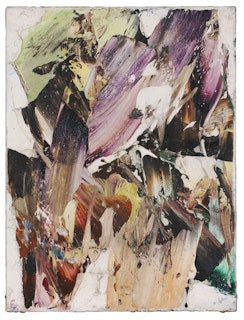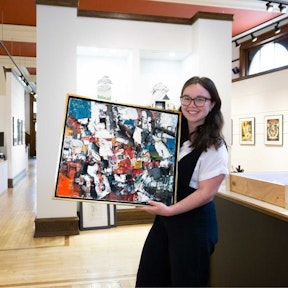Refus Global - 75 Years On
Madison Beale | August 9, 2023
This August, Mayberry Fine Art is celebrating and exploring the legacy of the Automatists with a virtual exhibition of available and previously sold works by the group members. Read more about the movement in this article.
75 years ago today marks the beginning of a new era in Canadian arts and culture. A manifesto entitled Refus Global (“Total Refusal”) was published and its message permeated throughout the country’s conscience. The manifesto and the art that followed as a result of it prompted reflection on who we are and what we value artistically as Canadians. The manifesto aimed to usher a shift in taste and move away from pastoral, placatory scenes to something indefinable that operates on “pure qualities and not on realities”: abstraction. (Borduas, 1947)

Paul-Emile Borduas
Oil on Canvas
7.75" x 10"
Previously sold through Mayberry Fine Art
Travelling to Europe was prohibitive for many Canadians due to the long distances and the exorbitant costs involved, notwithstanding the many years of war that made travel all the more difficult in the early 20th century. However, some artists had the chance to visit the continent and were exposed to new concepts in art that they had hitherto been sheltered from in Canada. Most influential of these was Surrealism, a pan-European movement concerned with exploring the underlying parts of ourselves that reason could not comprehend.
The name “Automatists”, as the manifesto’s group of signatories would come to be known, was given to them by journalist Tancrède Marcil after an exhibition of their work predating Refus Global. As opposed to the appropriation of pejorative criticism (à la the “Impressionists”), Marcil called them Les Automatistes because of the inspiration they took from the European Surrealists. As great admirers of the group, Borduas and other Automatists were entranced by André Breton’s treatises on spontaneous intuition and an “automatic” artistic process, one that prioritised the impulses of the creator over premeditated composition.
As the perceived need for cultural intervention in Quebec grew fervently among the Automatists, connections to a European movement became contentious within the group. Breton had personally invited the group to join the Surrealist movement and participate in an international Surrealist exhibition in 1947, but the Automatists declined. While Riopelle decided to sign their manifesto, Leduc severed his connections with the Surrealists. By June 1947 the group mounted an Automatisme exhibition at the Galerie du Luxembourg in Paris, showing the work of Barbeau, Borduas, Fauteux, Leduc, Mousseau and Riopelle. The summer of 1948 propelled the crest of Modernity to crash upon Quebec and Canada at large as the Automatists prepared to publish the culmination of their theories in “Refus Global” (“Total Refusal”).
400 copies of Refus Global were distributed. The manifesto was succinct and powerful, outlying what Borduas believed to be the crux of Quebec’s cultural crisis: an overdependence on the Catholic Church. Many Christian groups found his flagrant dismissal of the institution offensive. After its publication, Borduas’ words in the manifesto regarding the fates of radicals rang true: he was fired from the École du Meuble and decried as unstable.
Automatism pushed Canadian culture into an existential reckoning, causing somewhat of a collective crisis of identity and disillusionment. Following the atrocities of WWII, Refus Global questioned readers how life and culture could possibly continue as it had been before. The Automatists made way for a society that was more receptive to Modernity, albeit slowly. Art did not need to make sense in a world that no longer did- perhaps it could not any more. The concurrent, indomitable force that was Abstract Expressionism taking over the United States ensured that Modern Art in all its forms would flourish across North America in the 20th century as the war and its aftermath continued to ravage Europe.
By the mid-1950s the group began to disperse across the globe and Automatism had given way to Les Plasticiens in Canada as the movement slowed down. Scholarship surrounding Automatism began to emerge in Canada by the mid-1970s when the legacy of the Automatists had only begun being calculated. Today, art history leans toward understanding the development of abstraction in plurality, creating space to understand multiple movements across the world rather than a singular school of thought. In 1956, Borduas himself acknowledged the multiplicity of abstraction as a response to various, localized problems around the world. Depending on personal bias, one might argue that lyrical abstraction may have originated in Quebec - as critic Michel Ragon conceded in 1971 - despite being overshadowed historically by our southern neighbours. Automatism was Canada’s unique contribution to abstraction around the world, combining turn-of-the-century, avant-garde theory from Europe with Canada’s (and especially Quebec’s) unique political and social position within the world - indeed the art world at large.

Marcelle Ferron
Oil on Canvas
24" x 18"
$95,000.00
This August, Mayberry Fine Art is celebrating and exploring the legacy of the Automatists with a virtual exhibition of available and previously sold works by the group members. A small selection of later works will be displayed in our downtown location from the 9th - 15th of August, 2023. The largest painting displayed is Jean-Paul Mousseau’s 1957 Abstraction 2, flanked by Sans Titre by Jean-Paul Riopelle completed in the same year and Sans Titre by Marcelle Ferron from 1962. Mousseau’s rectilinear paint application may appear at odds with Ferron’s more lyrical approach to abstraction, yet both paintings are compositionally ordered and intuitive. The works by Riopelle and Ferron explore the possibilities of the application of paint with a palette knife; it is with these works that one may understand the automatic process as an exploration of the subconscious and an artist’s intuition.
The excitement during this period of rapid growth and intellectual exploration of the world by Canadians was shared with their country through Automatist writings and art in all its forms. With regards to painting, these works were not simply the syntheses of travels around Europe and meetings with great thinkers seeking refuge in North America. The Automatists’ paintings synthesised meetings their travels around Europe with the theories of great thinkers seeking refuge in North America. Their works coalesced innovative techniques and theories into works of art that transcend their physicality because of the theory that inspired them. There is no doubt that their work would decisively change Canadian culture forever.
The three works selected for display showcase the stylistic divergence of group members and the progression of Modern art in Canada following the zenith of Automatism. These paintings prompt reflection on the movement’s immediate results and contextualise Mayberry Fine Art’s contemporary gallery artists within Canada’s art history.

Sans Titre (1957)
Jean-Paul Riopelle
Oil on Canvas
18" x 21.5"
Previously sold by Mayberry Fine Art.
Sources and Further Reading:
Gagnon, F. M., & Viau, R. (1998). Refus Global (1948): Le manifeste du Mouvement Automatiste exhibition = Manifesto of the Automatist Movement. Services culturels de l’Ambassade du Canada.
Borduas, P.-E., & Ellenwood, R. (2009). Total refusal, Refus Global: The manifesto of the montréal automatists. Exile Editions. (English Translation)
Nasgaard, R., & Ellenwood, R. (2009). The Automatiste Revolution: Montreal, 1941-1960. Douglas & McIntyre.
McKaskell, R. (1993). Achieving the modern: Canadian abstract painting and design in the 1950s = L’arrivée de la modernité: La peinture abstraite et le design des années 50 AU Canada. Winnipeg Art Gallery.